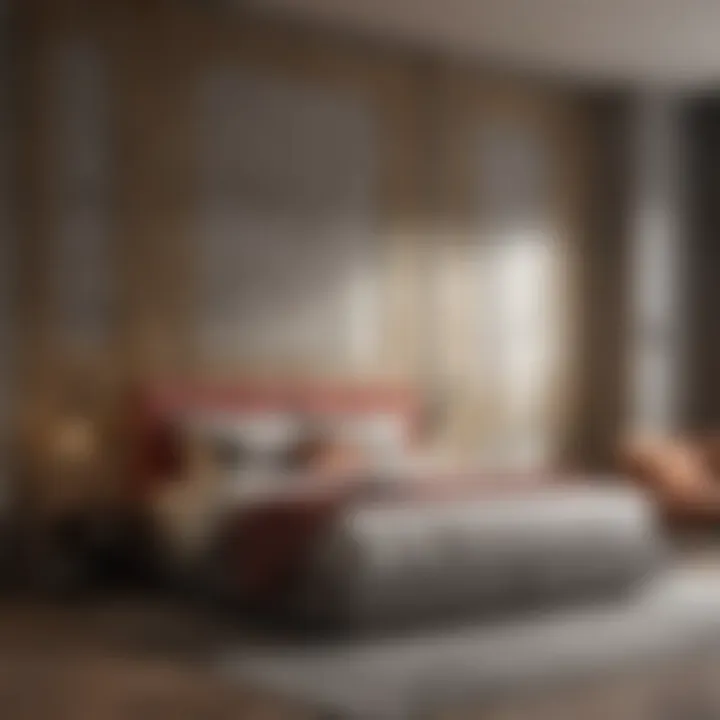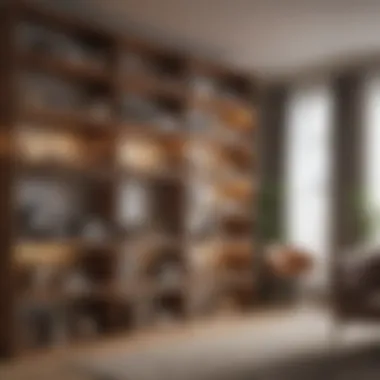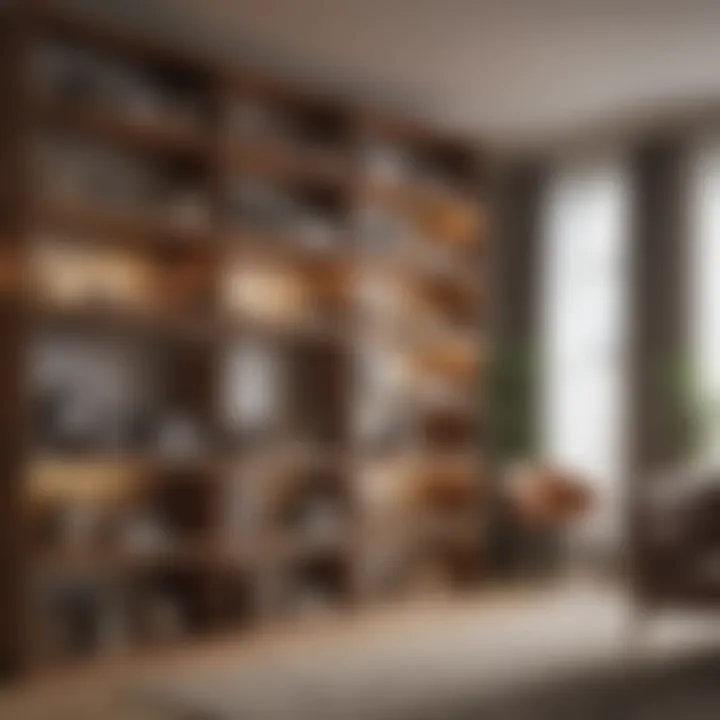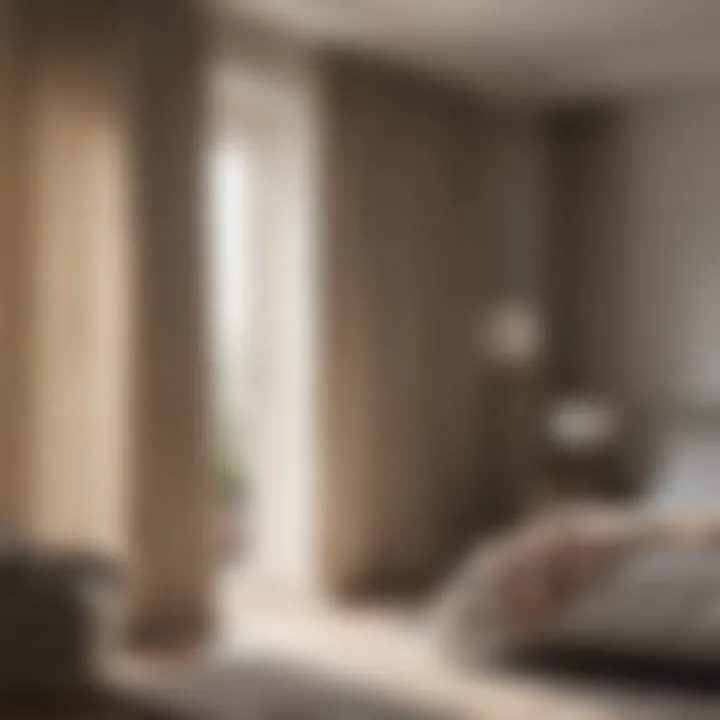Creative Ways to Split a Bedroom into Two Areas


Intro
Dividing a bedroom into two distinct spaces can enhance both functionality and design. As many homeowners and renters navigate the challenges of limited square footage, this practical approach offers a solution that resonates with contemporary living. This article will examine various methods to achieve an effective division of space, identifying key considerations in design and practicality.
Design Inspirations
Design is a crucial component when creating your divided bedroom. The way you choose to partition the space will significantly influence the overall aesthetic and functionality.
Latest Trends in Bath and Bedroom Design
Recent years have seen a surge in multifunctional spaces. Designers are increasingly incorporating flexible partitions, such as sliding doors or room dividers, which allow for easy reconfiguration of areas. This trend reflects a growing demand for adaptability in home design, where spaces need not be static but serve multiple purposes. The use of transparency in materials, like frosted glass, can also visually open a room while still providing necessary separations.
Color Palettes and Themes
Choosing the right color palette is essential when dividing a room. The colors can guide the perception of space and even mood. Soft, neutral tones create a sense of tranquility, while vibrant colors can energize a space.
- Neutral Colors: Gray, beige, and soft whites can make areas feel larger and more cohesive.
- Bold Accents: Adding a pop of color through decorations or furniture can define the separate areas creatively.
In terms of themes, a cohesive style throughout both spaces will enhance flow. Consider options like minimalist, zen, or contemporary to maintain harmony in design.
Functional Elements
Beyond aesthetic appeal, functionality must be prioritized when dividing a bedroom. The following points provide insight into optimizing space effectively.
Space Optimization Tips
Effective use of vertical space can yield significant benefits in a divided bedroom. Here are some strategies to consider:
- Wall-Mounted Shelves: Utilize walls for storage, reducing floor clutter.
- Under-Bed Storage: Integrate storage solutions beneath bed frames to maximize utility.
- Room Layout: Consider angling furniture or positioning items to create a more open feel, even within defined spaces.
Multi-Functional Furniture Choices
Selecting the right furniture is often key to achieving a well-divided room. Here are some recommendations:
- Convertible Sofas: These can serve as seating by day and transform into beds by night, making them ideal for small spaces.
- Partitioning Bookshelves: These dual-purpose items can delineate spaces while providing storage.
- Foldable Desks: Offering a workspace that can be concealed when not in use adds versatility to your division.
"Functional design meets aesthetic appeal when thoughtful choices are made in furniture and layout."
Prolusion to Bedroom Division
Dividing a bedroom into two distinct spaces is an increasingly relevant topic for homeowners and renters alike. As living spaces become more versatile, the need to maximize functionality without sacrificing style has emerged as a priority. A well-executed division can transform a bedroom into a multi-purpose area that accommodates various activities like sleeping, working, or relaxing. This article will unpack the strategy behind effectively partitioning a bedroom, touching on design, materials, and other practical considerations.
Understanding the Need for Division
Living in a modern world often means managing multiple tasks within a limited space. Many individuals find themselves needing both a restful sleeping area and a space to focus on work or leisure. Such a separation is not merely about physical boundaries; it is about creating an environment conducive to productivity and relaxation. The need for division in a bedroom can arise from several factors: the sharing of space with roommates, children needing a study area, or simply a desire for organized living. Identifying these needs is the first step in determining how to approach the task effectively.
Benefits of Creating Separate Spaces
The advantages of dividing a bedroom extend beyond aesthetic improvements. One notable benefit is the enhancement of privacy. For individuals sharing a room, establishing separate zones allows each person to conduct private activities without interruption. Additionally, it leads to improved organization. Each area can serve a specific function, reducing clutter and helping occupants maintain focus. Furthermore, separate spaces enable better use of natural light. For instance, each section of the room can be designed to maximize light exposure, enhancing the overall ambiance.
"A well-planned bedroom division can significantly improve both functionality and comfort."
In summary, the process of dividing a bedroom not only addresses practical needs but also offers improvements in privacy, organization, and light usage. An effective division strategy can redefine personal space, providing an overall better living experience.
Assessing Your Space
When it comes to dividing a bedroom into two spaces, the initial step should always be a comprehensive assessment of the overall space. This step is not merely a suggestion but a crucial foundation upon which successful division rests. By analyzing your room's dimensions and layout, you can ensure that the end result aligns with both your practical needs and aesthetic desires.
Understanding the physical characteristics of your bedroom enables you to make informed decisions about partition options and design elements. For instance, a room with high ceilings may allow for taller bookcase dividers, while a smaller space may require more flexible solutions. The benefits of carefully assessing your bedroom include maximizing the use of space and ensuring that both newly created areas serve their intended functions effectively.
Room Dimensions and Layout Analysis
Begin by measuring the walls, noting the locations of windows, doors, and built-in features like closets. A floor plan drawn to scale can help visualize how separate areas could coexist. Consider factors such as:
- Room dimensions: Effective division requires a thorough understanding of how large the space is. Calculate the square footage and consider how each area can utilize that space.
- Layout flow: Walk through the room and observe how you naturally use the space. Understanding pathways, access points, and overall flow is essential.
- Natural light sources: Identify where the light falls best during day. You want to ensure that both sections receive adequate lighting to avoid small, dark corners in the newly created spaces.
The analysis of layout is vital. Ensure you have sufficient space for furniture arrangements after the division. High-traffic areas should remain open to allow for movement, and furniture should not block accessibility to either area. This awareness will help you optimize functionality while ensuring comfort.
Identifying Functional Requirements


With the dimensions and layout in mind, the next step is addressing the functional requirements of the newly divided spaces. This consideration involves asking yourself what each space will purposefully provide. The following aspects should be evaluated:
- Usage needs: Determine what activities will occur in each section. Will one area serve as a relaxation zone while the other caters to work or study? Pinpointing the exact purpose is essential.
- Furniture selection: Based on the intended use, select appropriate furniture styles and sizes. For instance, if one section becomes a home office, consider a desk that fits into the chosen design theme but also accommodates ergonomic needs.
- Storage solutions: Assess how you will tile up belongings within both spaces. Tailored storage can maximize function, ensuring each area remains organized.
"Understanding functional requirements is just as important as knowing the dimensions. What you plan to do defines what you need to create."
Thinking through these elements will ensure that the divided spaces not only look distinct but also work effectively for daily routines. By conducting an initial assessment of your space, you set a strong groundwork for a successful transformation.
Design Considerations
When dividing a bedroom into two functional spaces, design considerations play a crucial role. They ensure that both areas complement each other while serving their intended purpose. It is important to evaluate how the division will affect aesthetics, light, and privacy. A well-thought-out design can enhance both comfort and functionality, making it easier to live with the changes.
Aesthetic Harmony and Cohesion
Aesthetic harmony refers to the visual balance between the two spaces created by the division. It is vital to choose colors, materials, and decor that not only suit the individual areas but also work in concert with each other. For instance, if one area functions as a workspace, it could feature more vibrant colors for energy, while the relaxation area might incorporate softer tones. This careful selection of color and design elements fosters a seamless transition between zones.
The goal is to avoid a disjointed appearance where one space feels completely separate from the other. To achieve this:
- Use similar style in furniture.
- Stick to a coherent color scheme throughout.
- Consider continuous flooring options.
This approach is more appealing and can positively influence mood and productivity in both spaces.
Utilizing Natural Light
Natural light significantly impacts the ambience of a room. When dividing a bedroom, it is essential to consider how the changes will affect light flow. Ideally, the division should not obstruct windows or other light sources. A bright, well-lit space feels more inviting and less cramped, benefiting both areas.
Consider using clear partitions or lightweight fabrics to maintain visibility and light penetration. Tall shelving units can also serve as a divider while still allowing light to filter through. Here are some strategies:
- Place work areas near windows to optimize daylight.
- Use light-colored curtains that allow light to soften the separation.
- Position mirrors strategically to reflect natural light, enhancing brightness.
These choices can transform the overall experience of the divided spaces.
Maintaining Privacy
In a bedroom divided into two spaces, privacy becomes a critical consideration. Whether it's shared or single occupancy, each zone should provide a sense of personal space. This separation can be achieved through various methods, including room dividers, curtains, or screens. The goal is to ensure that each area feels comfortable without sacrificing openness.
Offering privacy involves thoughtful placement and material selection.
- If using shelves as dividers, opt for taller, solid ones that can block sightlines.
- Heavy curtains can create a cozy atmosphere while providing sound insulation.
- Adjustable screens can allow flexibility, catering to different situations or preferences.
Ultimately, a successful bedroom division should balance privacy with accessibility, creating spaces that people can use freely without compromising their comfort.
Partition Options
The choice of partition is critical when dividing a bedroom into two functions. It addresses not only the practicalities of usage but also influences aesthetic appeal and privacy. The various options available can be tailored to meet individual needs, budgets, and design preferences. Understanding these distinctions will guide you to making an informed choice that balances form and function.
Fixed Walls
Advantages of Permanent Solutions
Fixed walls present a durable solution for partitioning space. They create a firm boundary, ensuring privacy and reducing noise transmission between the two areas. This is particularly valuable for families or roommates seeking personal space. Moreover, they allow for incorporation of electrical outlets or built-in storage.
Since fixed walls are permanent, owners can invest in high-quality materials and finishes, enhancing the overall room aesthetics. However, this option can be costly and may necessitate professional installation.
Considerations for Building Codes
Understanding local building codes is essential before erecting fixed walls. Regulations may dictate wall height, permissible materials, and safety features. This can limit your choices and impact your renovation budget.
As a homeowner, compliance ensures safety and can prevent costly fines or the need for revisions later. It’s always advisable to consult with a licensed contractor or your local authority to clarify all requirements before proceeding.
Room Dividers
Types of Room Dividers Available
Room dividers come in various forms, including screens, collapsible partitions, and folding panels. Each type offers unique benefits. For instance, a folding screen can provide an instant visual separation without the permanence of a wall.
They are often portable and can be repositioned easily, making them suitable for renters or temporary solutions. However, they generally offer less sound insulation compared to fixed walls and may not ensure privacy completely.
Best Practices for Placement


The placement of room dividers is crucial for maximizing their effectiveness. Position them to create natural pathways between spaces without obstructing movement. Additionally, consider sight lines; a well-placed divider can enhance the room's aesthetic appeal.
Arranging furniture nearby can help integrate the divider into the overall design while ensuring both spaces remain functional.
Curtains and Screens
Maximizing Flexibility
Curtains and screens offer flexibility in partitioning. They can be opened or closed based on the requirement, allowing for customizable privacy levels. This adaptability is ideal for people who may need to modify their space frequently.
However, they usually provide minimum sound insulation. Therefore, they may not be the best option for spaces where noise is a concern.
Choosing Suitable Fabrics
The choice of fabric for curtains is important. Heavier fabrics can provide more privacy and sound insulation. Light fabrics may allow light to flow through, maintaining an open feel.
A balance between style and function should be maintained. Selecting colors and patterns that complement the existing decor can enhance the visual impact.
Bookshelves as Dividers
Adding Storage Solutions
Bookshelves double as decorative elements and functional storage. They can occupy vertical space effectively, maintaining an airy feel while providing additional place for books or decorative items. This integration of storage makes them a practical choice for clutter reduction.
However, it is important to ensure they are stable and securely anchored if they are tall. Otherwise, they might pose a safety hazard.
Styling Options Available
Bookshelves can be styled in various ways to enhance the aesthetic of the space. Consider mixing books with personal items or plants to create an attractive display. This can add character and warmth to the separation.
In contrast, a minimalist approach can keep the spaces feeling open. The choice of style will vary based on personal taste, but investing time in arranging items thoughtfully elevates the visual appeal.
Functional Enhancements
Enhancing functionality in a divided bedroom is crucial. After creating distinct spaces, it's important to think about how these areas can serve specific purposes. This section discusses how to create a workspace and a relaxation area, both of which can maximize the utility of your divided bedroom. Focusing on these enhancements can lead to a more enjoyable and efficient living environment.
Creating a Workspace
Considerations for Ergonomics
Ergonomics plays a vital role in workspace design. It ensures that the workspace promotes comfort and efficiency. This is especially important in a bedroom, where space may be limited. A key characteristic of good ergonomic design is adjusting the desk height and chair support. This helps maintain posture and reduces strain on the body. A well-designed ergonomic workspace can prevent discomfort and potential injuries, making it a popular choice for home environments.
A unique feature of ergonomic furniture is its adaptability. Many chairs and desks offer adjustable settings to accommodate various body types and preferences. This flexibility is advantageous because it allows users to switch positions throughout the day, further enhancing comfort.
Integrating Technology
Integrating technology into the workspace significantly enhances its functionality. This includes using devices that improve productivity, such as computers, printers, and smart home systems. A key characteristic of modern technology integration is its ability to create a seamless working experience. This is beneficial because it allows users to manage tasks efficiently without leaving their dedicated work area.
A unique aspect of incorporating technology is smart lighting and organizational tools. These features help in maintaining focus and organization. However, there can be disadvantages; for instance, excessive screen time or distractions from notifications can impede productivity in a workspace setting.
Designing a Relaxation Area
Furniture Selection
Furniture selection is critical when designing a relaxation area. It must provide comfort while fitting within the divided space. A prominent characteristic of effective selection is choosing furniture that caters to personal preferences while prioritizing comfort. This makes it an appealing choice in creating a calming environment.
Unique features of suitable furniture can include recliners, bean bags, or modular seating that can adapt to changing needs. The advantage is that these pieces can create a cozy nook for relaxation. However, one disadvantage may include limited space, which might restrict the size and variety of furniture chosen.
Lighting Considerations
Lighting considerations are essential in creating a soothing atmosphere. Good lighting can transform the mood of a relaxation area. A key characteristic of effective lighting design is the balance between natural and artificial sources. This makes it a beneficial aspect of interior design in the bedroom environment.
Unique features might include adjustable lamps and soft light fixtures that promote a serene ambiance. This can help individuals unwind after a long day. However, one must consider the potential disadvantage of over-reliance on low lighting, which may affect visibility during activities such as reading or mobility around the room.
Proper planning of functional enhancements positively influences your overall sleeping environment and daily routine.
Implementation Process
The implementation process is crucial in creating a functional division within a bedroom. It encompasses the planning and execution phases necessary for successfully transforming a single space into two distinct areas. It aids in establishing a clear roadmap, ensuring each task is well-organized and that resources are used effectively. By addressing various elements and considerations, this process can significantly enhance user satisfaction with the newly divided area.


Preparation and Planning
Preparation and planning serve as the foundation for the entire implementation process. These stages help in defining the scope of the project, identifying potential challenges, and organizing necessary actions before actual work begins.
Budget Planning
Budget planning is a key aspect that ensures the project stays financially viable. It involves estimating costs related to materials, labor, and additional services. A well-thought-out budget helps in preventing overspending and promotes resource management. It is a popular choice because it allows homeowners to prioritize necessary elements while keeping extravagant expenses at bay. The unique feature of budget planning is its flexibility—adjustments can be made as needed. However, if not properly tracked, it can lead to financial pitfalls.
Timeline Establishment
Timeline establishment outlines the schedule for the division project. It serves to create a sense of urgency and accountability, ensuring tasks are completed in a timely manner. This is particularly beneficial for those with tight schedules or specific deadlines. Timelines can be adjusted based on project requirements, adding another layer of adaptability. However, unforeseen issues might impact this timeline, requiring homeowners to remain flexible in their planning.
Executing the Division
The execution phase entails carrying out the planned division, bringing the concept into reality. Decisions made during this stage will greatly influence the overall functionality and appearance of the divided space.
Diy vs Professional Help
Considerations between DIY vs professional help can significantly shape the execution phase. A DIY approach is often favored due to lower costs and the personal touch it affords. Many choose this route for smaller projects where skills and tools are sufficient. However, complex tasks might benefit greatly from hiring professionals, ensuring quality and safety. The unique feature of DIY is the sense of accomplishment it creates, while the benefit of professional help lies in expertise and reliability.
Necessary Tools and Materials
Identifying necessary tools and materials is crucial to executing the division effectively. Proper tools ensure that tasks are completed efficiently and safely. A specific characteristic of this aspect is the variety of materials available, which can influence the aesthetic and functional quality of the space. Different projects will require different sets of tools and materials, from simple hand tools for minor adjustments to larger equipment for structural changes. Failing to procure these prior can cause delays and disruptions in the workflow.
Post-Division Considerations
Post-division considerations are vital to ensuring that the newly created spaces in your bedroom not only serve their intended purposes but also maintain a harmonious aesthetic and functional quality. After dividing the room, attention to interior design adjustments and long-term maintenance will enhance the usability of each section. This stage is where the benefits of careful planning and execution truly manifest.
Interior Design Adjustments
When dividing a bedroom, adjusting the interior design is crucial. This not only establishes a new aesthetic but also enhances functionality.
Color Schemes
A well-thought-out color scheme plays a key role in achieving coherence between the two spaces. Neutral colors often work as a beneficial choice, creating continuity while also allowing for personalization. Practicality also becomes evident; lighter shades can make smaller areas feel larger and more open. Conversely, using dark tones can add warmth and intimacy to a relaxation area. One unique aspect of selecting a color scheme post-division is its ability to affect mood. Certain colors promote calmness while others can energize. Thus, thoughtful color selection allows for differentiated environments within the same room. This attention to detail can positively impact how each area is perceived and used daily.
Accessory Placement
Accessory placement greatly contributes to the functional and aesthetic quality of both spaces. A critical aspect of accessorizing is ensuring that each area feels complete and defined while maintaining an overall design theme. For instance, incorporating rugs can delineate different sections of the room visually. The strategic placement of mirrors can also help light bounce around while creating an illusion of more space. A unique feature of effective accessory placement is the balance it brings. Accessories should complement the color scheme and maintain proportionality to the room's scale. However, overcrowding an area can make it feel cluttered, diminishing its purpose.
Maintenance and Upkeep
Ongoing maintenance is crucial to uphold the integrity of the division and its function. Regular upkeep ensures that the aesthetic appeal and practicality of each space are maintained over time.
Routine Cleaning Recommendations
Routine cleaning plays a significant role in the longevity of both the divided spaces and their furnishings. Establishing a cleaning schedule tailored to the specific needs of each area allows for efficient management. It is essential to address dust accumulation, especially in areas with electronics or textiles. One key characteristic of effective cleaning is its preventative nature. Staying ahead of dirt can prevent significant wear and tear on furniture and decor. The unique advantage of creating a cleaning routine is that it instills discipline and maintains a fresh environment, making the spaces pleasant to live in long term.
Long-term Durability Considerations
Considering the long-term durability of materials and finishes during the division can have lasting effects. Selecting high-quality furnishings and resilient materials is a beneficial choice, as it reduces the frequency of replacement or repairs. Easy-to-maintain materials, such as synthetic fabrics for upholstery, can withstand wear better than standard textiles. A unique feature in evaluating durability is its influence on overall cost. Investing in durable materials may yield higher initial costs but will save money in the long run through reduced need for replacements or repairs. Understanding these aspects can also significantly reduce stress, knowing that your divided spaces are both beautiful and reliable.
Key Takeaway: Post-division considerations not only elevate the aesthetic but also enhance the practicality of the newly created spaces. By addressing interior design adjustments and implementing regular maintenance, homeowners can fully optimize their divided bedrooms.
Finale
In the exploration of dividing a bedroom into two spaces, it becomes clear that this topic merits careful consideration. The conclusion serves as a vital synthesis of all the benefits and practical aspects addressed throughout the article. Understanding how to effectively partition a bedroom can transform its functionality and aesthetic appeal simultaneously.
Recapping the Benefits of Bedroom Division
To summarize, dividing a bedroom allows homeowners and renters to maximize their living space. It enhances usability, making it conducive to varied activities such as work, relaxation, or sleep. The separation of areas promotes a better psychological distinction, enabling individuals to shift their mindset according to the designated function of each space. Furthermore, it can increase privacy within shared living arrangements, ensuring personal boundaries are respected.
Additional advantages also include:
- Improved organization: By designating specific areas for specific purposes, clutter can be minimized.
- Flexibility: Room dividers such as decorative curtains or bookshelves can be adjusted or moved, adapting to future needs or preferences.
- Aesthetic enhancement: Different design elements for each space can add visual interest and make a room more dynamic.
"A well-separated space can nurture creativity and relaxation, fostering a harmonious living environment."
Encouragement for Personalization
While the structural aspects of a divided bedroom hold significant merit, personal touch remains equally important. Homeowners should embrace the opportunity to tailor their spaces according to personal needs and preferences.
Personalization can manifest in various ways, such as:
- Choice of colors: Different hues can evoke various emotions. Therefore, selecting a unique color scheme for each part can enhance the desired atmosphere.
- Decorative elements: Using personal mementos, artwork, and textiles allows individuals to express their identities.
- Functionality alignment: Consider the specific activities each space will host. Different furniture styles may be needed for an area focused on work versus one meant for relaxation.
Incorporating personal style not only makes the new spaces more enjoyable but also ensures they reflect individual values and lifestyles. The importance of this cannot be overstated; personal design choices lead to a more satisfying living environment. Thus, the process of dividing a bedroom should be seen as an opportunity for creative expression and functional optimization.















